Where Are Some Funny Places to Put Small Dogs
One time upon a time I was a cat person. Then, in college, I watched my Geology field trip friends pal effectually with their dogs. I decided I wanted a canine best friend. Bad.
I researched A LOT of canis familiaris breeds to determine which was the correct one for me.
Small athletic dogs weren't even on my radar and I settled on a Rhodesian Ridgeback.
Then I concluded upwardly living with a roommate that got a Dachshund puppy. I took care of him when she went out of town – which was a lot.
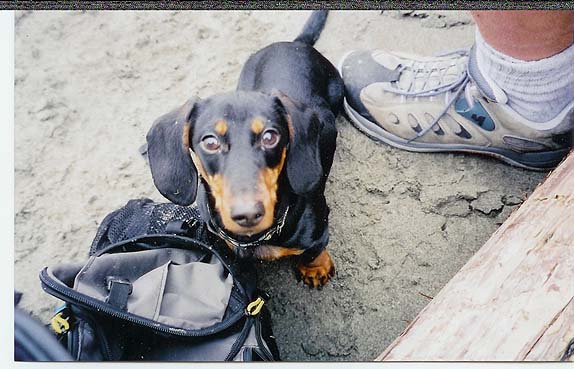
I couldn't leave him home lonely so he became my abiding take chances buddy.
Not "knowing whatever better" I did all of the things with him that I would accept done with a big dog.
As I found out later, Dachshunds were bred for tracking rabbits, badgers, and other nasty critters.
These small, tough and able-bodied dogs were used to roofing a lot of basis through the wood.
It'southward no wonder my Dachshund Chester immediately took to things like running 3-v miles with me, hiking, and generally spending time in the outdoors.
I discovered why hiking with a small dog is better.
I've been hiking with my miniature Dachshunds for almost 20 years and writing about hiking with small dogs for over 10.
I've learned that Dachshunds aren't the merely small dog brood that are good at hiking and beloved information technology.
I know several people that hike with small dogs.
Through those examples, and my enquiry, I've discovered that Chihuahuas, Yorkies, and Pomeranians are pretty skillful hikers likewise. (probably the most common pocket-sized hiking breeds next to Dachshunds).
While some breeds – because of their breed history and build – are more than typically seen on the trails, I've seen a whole lot of "non typical" breeds also.
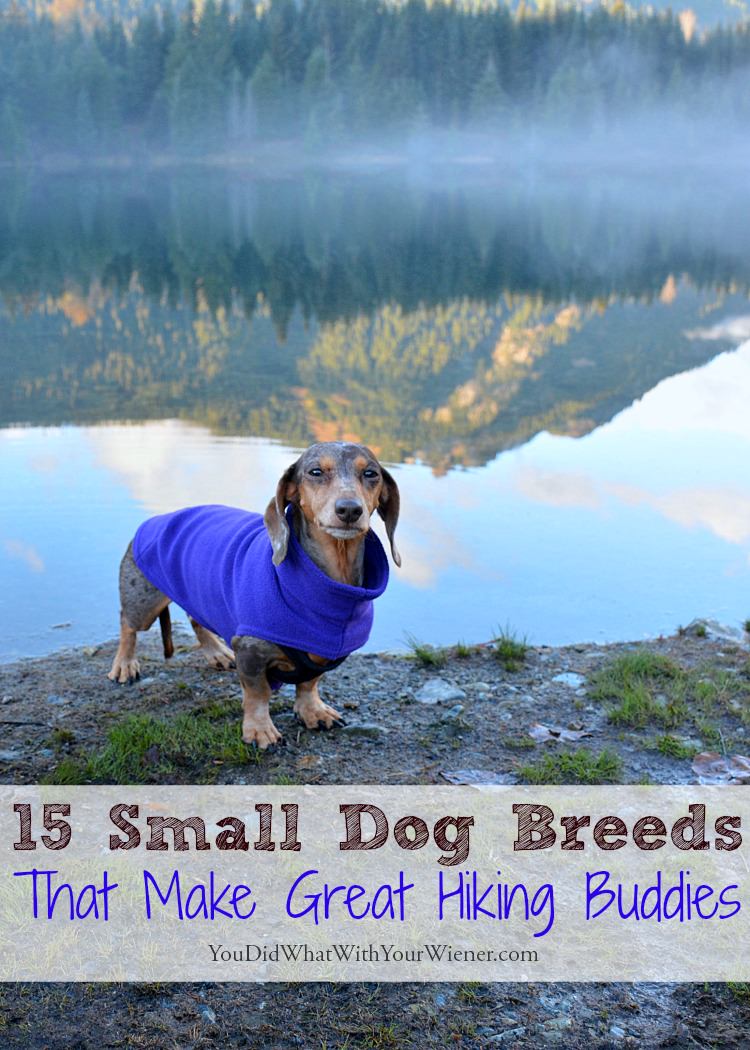
While almost whatsoever canis familiaris can larn to honey hiking and be skillful at information technology, I compiled a list of 15 small domestic dog breeds that are best suited to be hiking companions (don't forget that mixes of these breeds, and sometimes purebreds, can be found at shelters/rescues and past searching Petfinder.com)
Small Dogs That Can Hike With the Large Dogs
Note: please enquiry and proceed in heed grooming requirements if any of these breeds catch your eye. I am SO GLAD I ended up with a brusque-haired Dachshund because they are like shooting fish in a barrel to make clean off later on a hike. A definite reward of dogs with longer hair though is that they don't go cold as like shooting fish in a barrel. Make sure you have enough fourth dimension or money for regular grooming though if you get a longer haired dog.
Small Athletic Dogs (typically under 12 lbs)
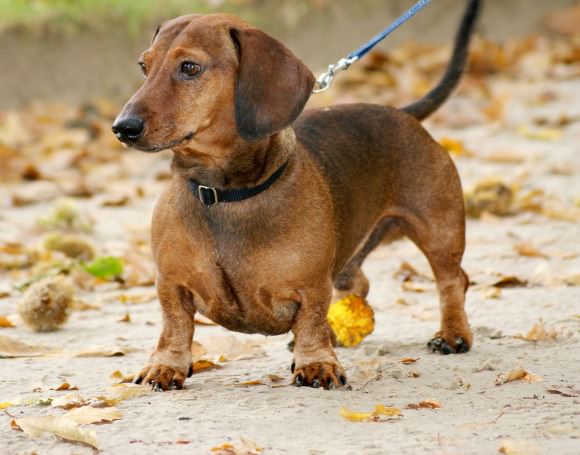
i) Dachshund
The standard Dachshund (16-32 lbs), which is a blazon of hound, originates from Germany, and was bred to aroma, chase and affluent out badgers from their dens.
The miniature Dachshund (5-11 lbs) was bred to hunt smaller animals, such equally rabbits. In addition to the standard and miniature Dachshund sizes, the unofficial "tweenie" Dachshund size falls somewhere in-between in size and weight (12-fifteen lbs).
Dachshunds come in three coat patterns – smooth, wire, and long – and in many colors.
No matter which size, these are small dogs with big personalities, and are generally recognized every bit being lively, charming, comical, and brave.
They are devotedly loyal to their owners (I can, of class, attest to this), and will likely follow their chosen person to the ends of the earth.
Don't let their long bodies and short legs fool you into thinking these "sausage dogs" can't keep upwardly on the trails.
They have far more volition and tenacity than one may call back, and are surprisingly athletic.
The primary wellness concern a Dachshund owner should exist aware of when hiking with their pup is their predisposition to spinal problems, such equally IVDD.
Living a healthy lifestyle that prevents obesity is 1 of the primary means of fugitive this. Keeping their muscles flexible and strong helps a lot too.
Some veterinarians say that hiking with a Dachshund is actually a good way to build spine-supporting muscle structure.
Nonetheless, a Dachshund owner needs to be aware of IVDD symptoms and so they can spot the start signs of trouble. I likewise highly recommend hiking and walking them with a harness that doesn't press on their neck if they pull.
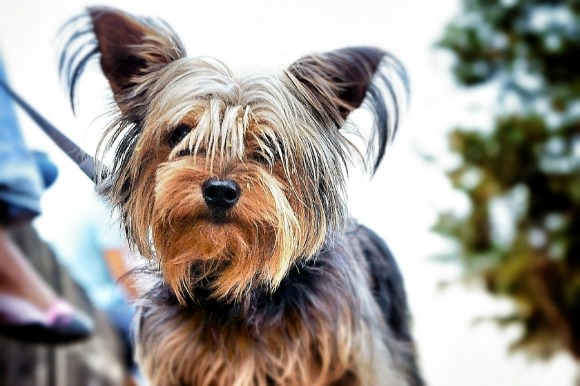
2) Yorkie
The Yorkshire Terrier (7-15 lbs) was adult in Yorkshire, England during the 19th century equally ratters to control rodents in fabric mills and coalmines.
They have big personalities and need plenty of regular practice and mental stimulation equally they are pretty inquisitive dogs.
They are known to be brave, adventurous, low-cal-footed and fast, and at times carry a sure air of "importance" in their demeanor.
I've read about Yorkies being good hiking dogs in various forums throughout the years, and become the impression that they're pretty much second backside Dachshunds.
I've seen plenty of Yorkies leading their people up hiking trails.
Still, due to a tendency to exist "darters", it's important they be kept on a leash and piece of work extra hard on recall grooming.
Yorkies are known to suffer from knee issues more other breeds, so this is something that all owners should go on an alert center out for.
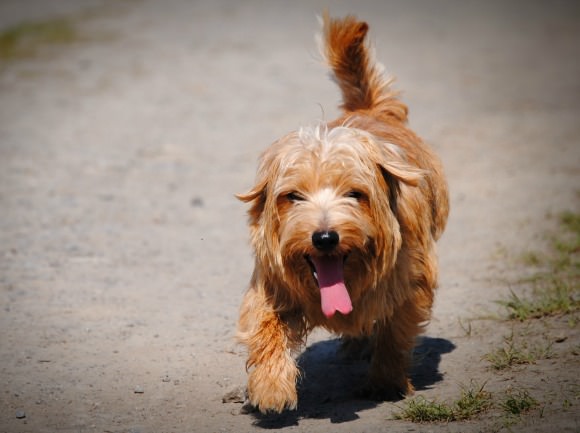
three) Norfolk Terrier
Of British heritage, the Norfolk Terrier (11-12 lbs) is considered to be the smallest, as well as ane of the most even-tempered breeds inside the terrier group.
Originally bred every bit vermin hunters with a strong prey drive, these dogs are compact, active, agile, and notably courageous.
Norfolk Terriers thrive off of human and canine companionship, which makes them both loyal and generally dog-friendly trail mates.
In general, these dogs are powerful, athletic, fearless, downwards to get muddy, and full of energy to run or climb.
As stubborn as they tin be, they are devoted to their humans and tin can brand bully hiking dogs.
In regards to health, Norfolk Terriers ofttimes have issues with their hips and joints, and should be monitored in the issue of regular hikes.
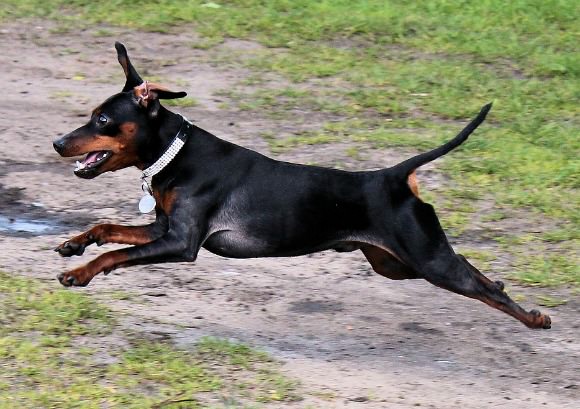
4) Miniature Pinscher
Originating from Germany, Miniature Pinschers, or Min Pins, (eight–x pounds) are well-balanced, sturdy and active dogs.
They are assertive, proud, energetic, and decumbent to helping themselves to their own adventures, whether you lot choose to come up along or not.
These dogs typically beloved fast-paced and rigorous exercise, making them great hiking partners.
To your dismay, y'all may fifty-fifty find them waiting and prepare for MORE play time after your hike.
They can almost always be counted on to bolt after wild animals, as well as disregard your beckoning calls to come up back, which is why they need to be kept on a leash during outdoor excursions.
Equally is common with pocket-sized dogs, Miniature Pinschers' knee joint caps can be unstable and may be prone to popping out of position (luxating patella), which is why it's important to keep them lean.
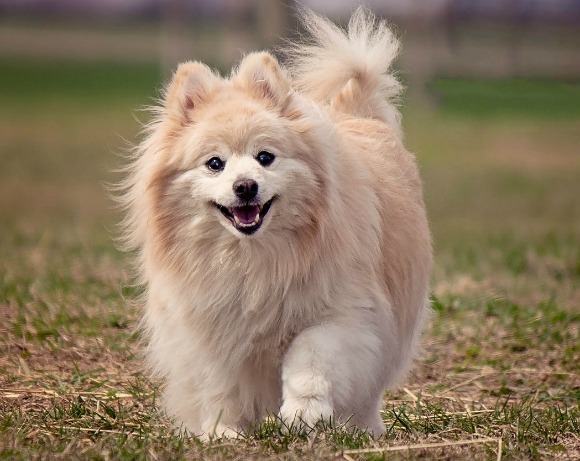
v) Pomeranian
Named after the Pomerania region of Germany and Poland, Pomeranians (4-8 lbs) became a pop dog breed when Queen Victoria endemic and showed her dearest Pom-Poms in the 19th century.
Nicknamed the "little dog who thinks he tin", Pomeranians are confident, vivacious, and spirited dogs.
They are far from a "passive" breed, and accept big personalities that require an equally strong-willed owner.
They're curious and honey to proudly check out every site and odour with much excitement (all the while holding their heads up high).
Without proper training, they can be neurotic or aggressive towards other dogs, just every bit with any brood, this will vary from each individual dog to the adjacent.
Pomeranians take thick and beautiful fur coats that will go on them warmer than other select breeds. Nevertheless this may mean quite a bit of additional grooming for the outdoorsman who wants to take his/her dog along.
One of the most common wellness issues Pomeranians may face that would effect their ability to hit the trails is is tracheal plummet, which leads to the closing of their airway, and thus an intolerance to exercise.
It's extra important to utilise a harness that rests on their chest bone, instead of their throat, when walking or hiking with a Pomeranian.
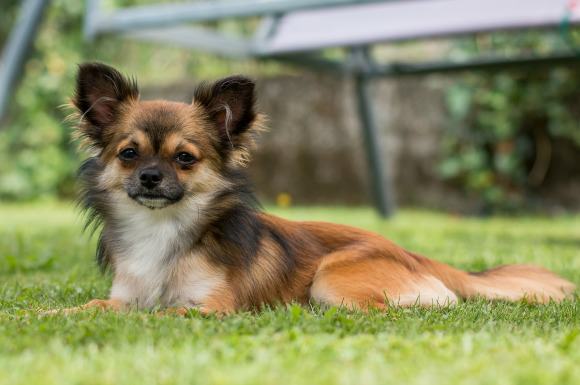
half-dozen) Chihuahua
Chihuahuas (4-6 lbs) have somewhat unclear origins, yet information technology'due south believed that they date all the way back to the 9thursday century in Mexican culture.
They come in all different shapes and colors, and come in both long and short glaze types.
Recognized as the smallest dog brood by many kennel clubs, these fiddling pups have a reputation of being feisty, entertaining, and comically quirky.
Chihuahuas have energy and a dearest for the sunny outdoors just like any other dog and I personally have seen plenty of them hike alongside their humans on trails here in Washington.
If you're considering taking your Chihuahua along for a hike, it's important to note that they're prone to loose human knee joints (luxating patella).
Also, they will likely need an outdoor jacket during fall and winter months, as they have minimal fur to keep them warm, their small body mass doesn't generate a lot of rut, and the brood is originally from a warmer climate.
Medium Athletic Dogs (typically nether 25 lbs)
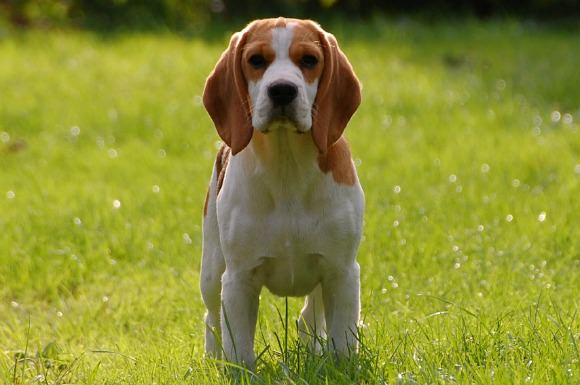
seven) Beagle
The Beagle (18-25 lbs) is a medium-sized aroma hound, adult in United kingdom to track and hunt hare.
The Beagle is a popular dog due to its platonic size, gentle demeanor, and friendliness towards children.
Information technology should be noted, however, that Beagles are tracking hounds to their very core, and tend to exist single-minded and easily distracted when they take hold of a olfactory property that interests them.
They have a notorious case of selective hearing, and often their instincts trump their desire to obey.
They need quite a bit of intentional do, which is why Beagles are awesome medium sized hiking dogs.
While they virtually assuredly should be kept on a ternion at all times, they are masters of the outdoors, and are nearly in their element when they're discovering new places and scents.
If yous cull a Beagle though, beware that they accept a tendency to "bay" loudly (howl), putting a damper on the enjoyment of others on the trail. If at all possible, that behavior should be discouraged.
Two health concerns a hiking owner should be aware of with their Beagle is their proneness to certain spinal disk diseases, also as a condition chosen "Funny Puppy", which can effect in weak legs and a crooked spine.
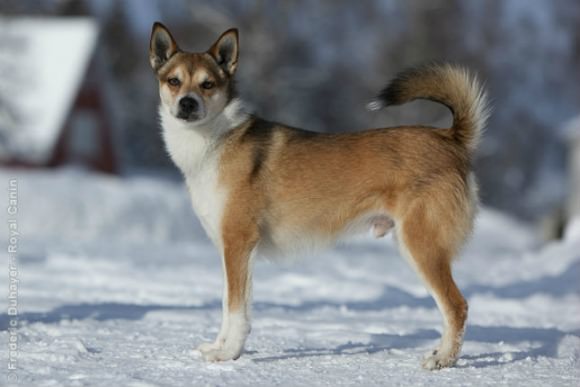
eight) Norwegian Lundehund
The Norwegian Lundehund (13-20 lbs) originates from Kingdom of norway, and was historically used to hunt puffins.
This domestic dog breed is pretty incredible, every bit they have the ability to turn their head backwards along their spine and plough their forelegs to the side at a 90-degree angle, much like human artillery.
In addition to this, they have upright ears that tin be folded shut to grade a nigh-tight seal, and SIX fully formed, jointed and muscled toes on their feet (as opposed to the normal iv toes that almost dogs have).
Because of their breed characteristics, Norwegian Lundehunds are designed to be the optimal outdoor dogs, assuasive them to movement, climb and jump with ease and a sure-footed confidence.
In addition to this, they are playful and almost completely non-ambitious.
There are currently only ane,400 estimated Norwegian Lundehunds in the world due to them condign nigh extinct during Earth War Two, and then if your middle is set on this breed, be prepared to spend fourth dimension and money on finding your pup.
While these dogs are generally salubrious, they can suffer from severe digestive disorders. There is typically no cure, although the disorders can often be managed and then long every bit the owner is willing to spend the necessary money for wellness intendance and proper nutrition.
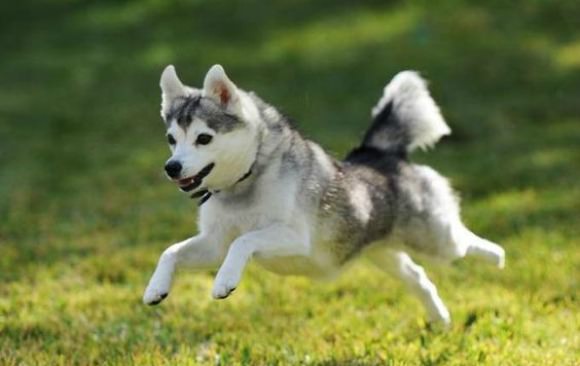
9) Alaskan Klee Kai
The Alaskan Klee Kai (10-15 lbs) was adult in the 1970s in order to create a companion-sized LOOKING version of the Siberian Croaking (information technology'south a breed unto itself though – it'southward non a miniature Siberian Husky).
Originally bred in private by an individual owner, this breed was not released to the public until 1988, making it relatively new and rare.
They are considered intelligent, active, high-energy, and loyal to their owners. They tin exist skittish and shy around strangers then need a lot of socialization.
They are considered pretty make clean dogs who don't accept a "dog aroma" and shed only lightly almost of the year (they do "accident" their coat twice a year though) so some say they are good dogs for people with allergies.
They make for agile dogs on the trail as they are excellent climbers and jumpers.
Their thick double glaze makes them very compatible for cool weather and snowy weather.
Thus far, this breed is considered to be gratis of whatever significant genetic defects, however this could in part be due to the "newness" of the breed and the relatively small-scale gene pool that currently exists.
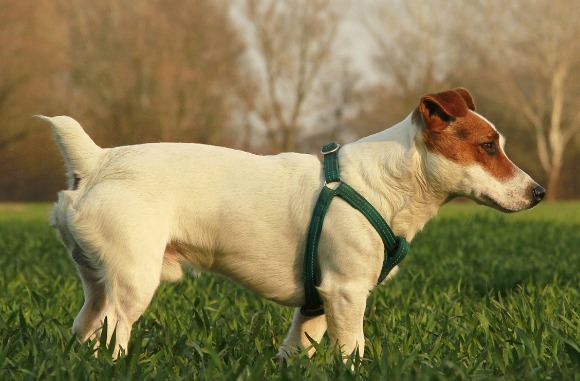
ten) Jack Russel Terrier
Developed in the 19th century to be highly efficient trick hunters, Jack Russel Terriers (14–18 pounds), or JRT for curt, today are some of the almost high-energy, hard-working, and intelligent dogs within the terrier grouping.
They are clever and inquisitive, withal, despite their want to delight, they take an equally strong (and at times impulsive) desire to hunt.
This breed is remarkably athletic, and volition do it's best to keep up at all times, likely out running, out balancing, or out jumping you.
They desperately need rigorous active periods, which is why they can brand exceptional hiking partners. They need an possessor who is willing to spend the necessary time with them to physically and mentally stimulate them.
The chief health concerns to be aware of if you desire to make an take chances dog out of your JRT are ligament problems in their knees, likewise as eye disorders, such equally cataracts.
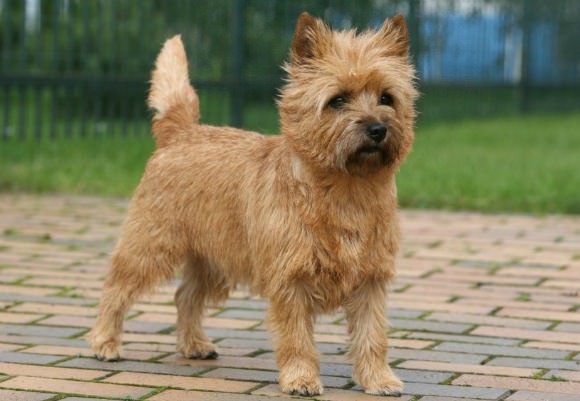
11) Cenotaph Terrier
The Cenotaph Terrier (13–18 lbs) is one of the oldest terrier breeds, and originated in the Scottish Highlands as working dogs and ratters.
Equally one would await with any terrier, this breed is intelligent, hard-working, and is happiest when it's using its superior sense of scent.
These dogs are swell learners, and honey to participate in any event that's taking identify effectually them (perchance ane of the reasons why a Cairn Terrier was chosen to play the infamous Toto from The Wizard of Oz).
Cairn Terriers are very intelligent and curious. They would brand first-class and loyal trail mates, with an ability to maybe out-navigate their human being.
Hiking volition also requite them enough of chances to apply their neat sniffer.
Cairns are potent and sturdy dogs, however they are prone to some hereditary health problems, such as cataracts and hip dysplasia.
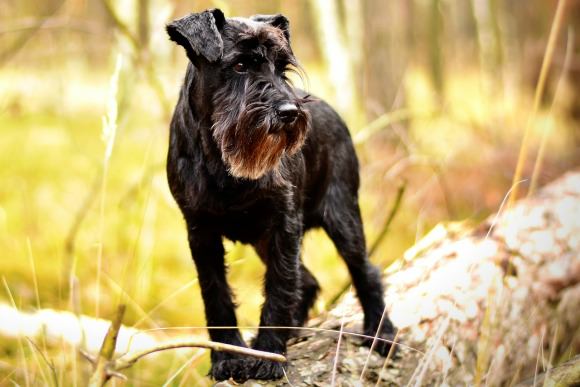
12) Miniature Schnauzer
The Miniature Schnauzer (10 -18 lbs) was developed in Germany in the late 19thursday century as a ratting domestic dog for rural farms.
As i of the top 15 about popular dogs in the U.s., this brood has a wide range of temperaments, which will vary from dog to domestic dog.
That being said, the Mini Schnauzer is generalized as being tough, warning and spirited, still obedient to control, with a friendly demeanor and an often aloof mental attitude towards those outside of its direct circle.
Miniature Schnauzers make excellent travel companions, with a desire to please and a marvel for the world.
As ratters, this breed has a potent casualty drive, and loves activities that let them to run and seek.
Because of their potent casualty drive, it's important to continue them on ternion when hiking and so they don't chase after a darting squirrel.
These dogs are a by and large salubrious breed, however they can suffer from wellness problems associated with high fat levels such as hyperlipidemia or diabetes (all the more reason to feed your Mini Schnauzer healthy nutrient and live an active lifestyle with him/her!)
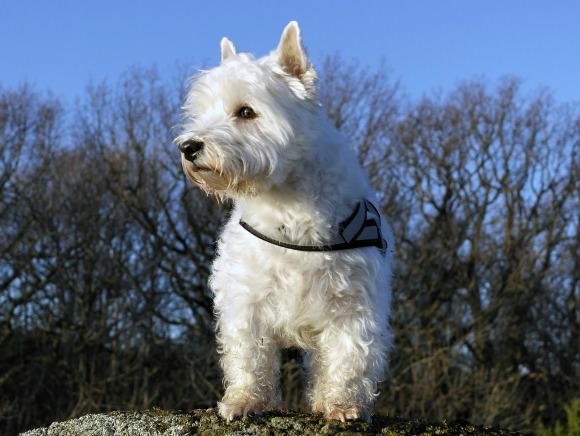
13) West Highland White Terrier
The West Highland Terrier (15-20 lbs) reigns from the lands of Scotland, and was an ideal vermin and fox hunter due it'south stark white coat that would differentiate it from the hunted casualty.
These dogs have a high self-esteem, and concord themselves with an air of confidence and assertiveness.
That existence said, they are mostly friendly and welcoming of guests, and these decorated-torso dogs dear to be involved in their household events.
In full general, the word "jolly" is ofttimes used to describe the Westie, making them fun adventure companions. Their hunting background means that they are sturdy on the trail.
This breed is predisposed to both breed specific AND non-breed specific wellness concerns, such as hernias, Addison'southward disease, liver affliction and "westie jaw".
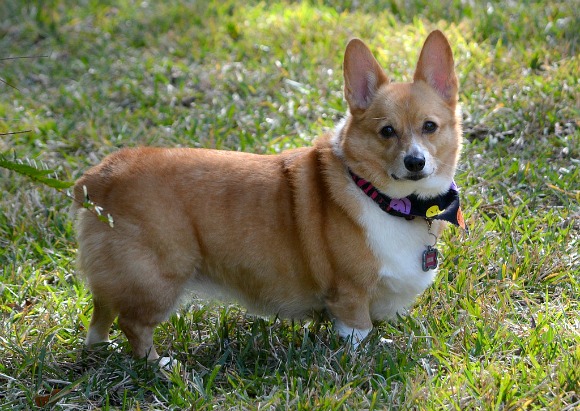
14) Pembroke Welsh Corgi
Yay for another long and low brood on the list!
The proper noun "Corgi" literally means "dwarf dog" in Welsh.
The Pembroke Welsh Corgi (20-25 lbs) is a domestic dog that originated in Wales and was used to herd cattle in rural areas.
The Corgi is a herding dog through and through, and loves games that involve chasing and agility.
These fun-loving and intelligent dogs have no problem keeping upward on the trail, however they can be domineering, and at times snippy towards other dogs or passerbyers, so exist aware of this if you're taking your Corgi on a popular trail.
Aside from some centre disorders, this breed is generally healthy, with their main crusade of death being cancer or former age.
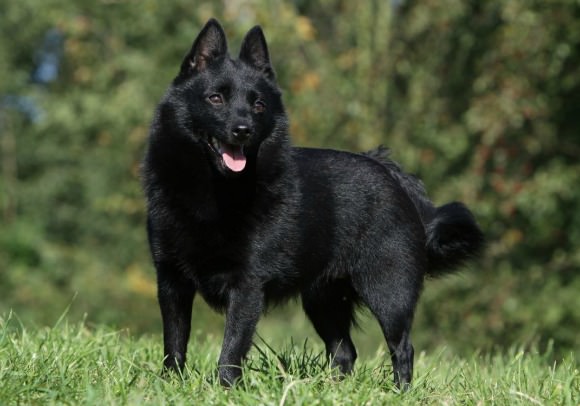
fifteen) Schipperke
This Belgian breed originated in the sixteenth century, and hilariously holds the nicknames "little black fox" or "Tasmanian black devil" due to their mischievous, inquisitive, and impulsive nature.
The Schipperke (six-20 lbs) is highly curious, incredibly high-energy, and is always on the move.
Schipperkes thrive on athletic activities, and hiking can exist an crawly ways of engaging them mentally, while besides working some of that energy out.
They tend to be willful and, if overindulged, can be rather manipulative. Making outdoor adventures a regular action for you and your "niggling black fox" tin can aid in bonding, while besides providing great preparation opportunities.
In full general this brood has few health concerns, however 15% of todays breed population carries a genetic mutation called MPS IIB, which can affect their balance and negotiation of objects.
Bated from this, the biggest disservice you could do to your Schipperke is withholding physical do and overfeeding, as this tin in turn lead to joint and skeletal bug.
Other Advantages of Modest Dogs
There are many reasons someone might prefer to own a small dog rather than a large one.
Small dogs make bully hiking and camping ground buddies because they can snuggle inside your sleeping bag to go along yous warm at night; they're a great conversation piece on the trail considering people are amazed that "your little doggy fabricated it"; and you tin can easily carry them out of the woods if they get hurt or tired.
There are other advantages to a pocket-sized dog too.
Generally, a smaller dogs is meliorate if you live in a pocket-sized space and they are less expensive to feed.
Too, if you like to travel a lot, a small dog is more likely to be accepted past dog-friendly hotels that have a weight limit.
Speaking of travel, if you live in a RV total time, or are on a #Vanlife adventure of a lifetime, a smaller dog might exist a more than user-friendly travel buddy.
As you tin can run into, big dogs are not the only ones that are peachy for hiking and adventuring.
A dog'due south exercise needs, and the activities they enjoy, depend more on their breed and temperament than size.
It makes me sad when I come across dogs not getting the exercise they demand but because of the stereotype that small dogs don't need information technology.
I know the stereotype exists considering I hear then many "shocked" comments when we are out hiking.
If you want dog y'all tin can take on many hiking adventures, simply you're not sure a big canis familiaris is for you, I highly propose yous check out some of the breeds on this list.
Source: https://youdidwhatwithyourweiner.com/15-small-dogs-breeds-best-for-hiking-camping/
0 Response to "Where Are Some Funny Places to Put Small Dogs"
Post a Comment